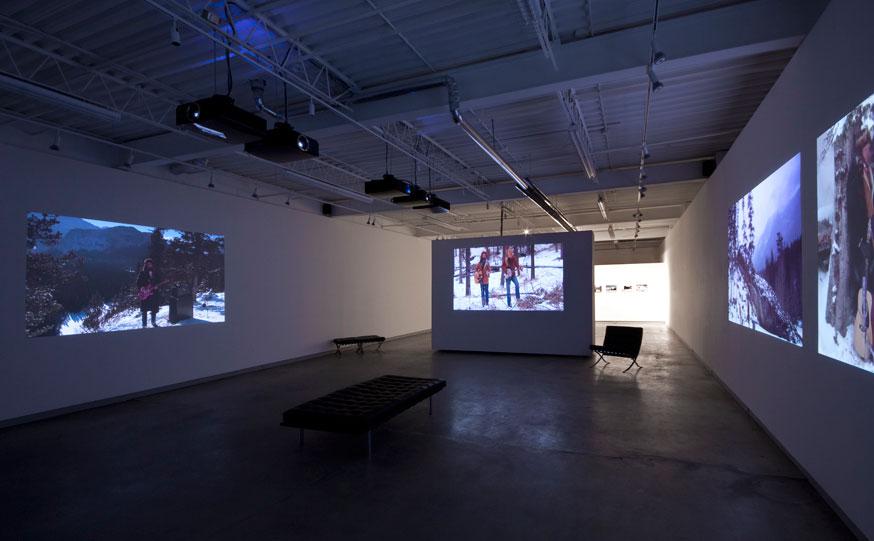1. Annie MacDonell at Mercer Union, Toronto
Annie MacDonell’s “Originality and the Avant Garde (On Art and Repetition)” elegantly entwined her photographic series The Picture Collection with her film work Originality and Repetition through an austere and self-reflexive installation. Both the photographs and the film feature the same set of images culled from the “Reflections” and “Mirrors” folders of the Picture Collection at the Toronto Reference Library. In re-photographing images containing either doubled or reflected imagery, MacDonell combines appropriation and creation; she brings ideas of originality and processes of image-making themselves into question. In the film, an actor playing the role of “The Caption” stands in for MacDonell, delivering a critical monologue on the importance of originality and newness to modernist thought while arguing repetition can be poignant and productive—that is, far from inane.
The installation seemed a meditation on framing. MacDonell built a full-scale model of her studio out of mirrored Plexiglas in the gallery space. From the outside, it mirrored photographs presented on the gallery wall, while on the inside, it alternated between functioning as screening room and, upon the film’s completion, becoming a camera obscura, projecting an inverted view of the gallery outside—a view reminiscent of the image on the ground glass of a view camera. Despite having a physical barrier partitioning the space, inside and outside were blurred, as was the distinction between place of production and place of presentation.
MacDonell’s repetition is not the unchanging type of such pattern-making devices as the Spirograph or the stencil. To me, it seems more Kierkegaardian: in the act of repeating, there is an inherent transformation, so that “true” repetition may be impossible. The narration of MacDonell’s film suggests that when the smoke of modernism finally clears, we will perhaps learn that “holding fast to the centre rather than racing forward to the end”—as 20th-century avant-gardes did—is a more productive approach.
2. Ragnar Kjartansson at Scrap Metal, Toronto
The rise of Scrap Metal itself should really be in my top three for 2012; with the future of the Ydessa Hendeles Art Foundation in flux, it is wonderful to have an ambitious new collector’s gallery in town with interesting programming and (since opening its doors in December 2011) a lively exhibition schedule. Seeing Icelandic artist Ragnar Kjartansson’s The End, half of his 2009 Venice Biennale contribution of the same name, in a gallery that was able to give the work the physical space it deserves was indeed a treat.
Kjartansson’s work is immediately monumental. His performance and performance-for-video pieces deal primarily with heroically enacting chauvinistic feats as a deconstruction of masculinity. In The End, Kjartansson takes his übermensch persona to another extreme—he has previously appeared as a blues-singing Viking—while simultaneously evoking Caspar David Friedrich’s wanderer and the cover of Supertramp’s 1977 album Even in the Quietest Moments. In his Friedrichian braving of the elements, he unravels a man-in-the-wilderness myth in a way that is simultaneously romantic and self-effacing.
Like many of Kjartansson’s other works, The End plays with musical form, repeating phrases in a tizzy lost between crescendo and conclusion. Kjartansson and collaborator Davíð Þór Jónsson play various musical instruments amid the picturesque frozen lakes, snowy valleys, and sublime mountaintops of Banff. Each of the five video channels is a single shot of one or both men playing a part of their composition; the sound is that of all channels combined. The half-hour duration of the piece is a testament to the myth-making devotion, if not lunacy and compulsion, of the two men.
Kjartansson and Jónsson returned to the Banff Centre in late 2011 to lead a residency titled “The Soiree.” So far, I’ve heard tell of debauched nights at the Banff Springs Hotel, variety shows, expeditions and plenty of music along the way. I very much look forward to seeing what comes from this residency.
3. Mark Lewis at Daniel Faria Gallery, Toronto
Mark Lewis returned to his one-time home of Toronto with a really strong new set of works. The four films in “Man” simultaneously seemed excerpted from everyday life and rich with the “secret strangeness” that Jack Kerouac describes in his introduction to Robert Frank’s The Americans. Tied in equal parts to mapping space and analyzing the artifice of cinema, Lewis continues his camera-mediated meditations on contemporary urban life.
In keeping with virtually all of his films, each of the works in “Man” came in at under 10 minutes in length. In each film, Lewis manages to make something compelling and visually interesting that can hold its own in the gallery space without turning it into a screening room. In City Road 04 May 2012, Lewis employs the simple device of presenting an upside-down view to fully disorient the viewer. The movements of the camera take on an alien dimension as they shift the point of interest from street life, over a fence to a construction site, and then, eventually, to a distant skatepark. The comparably static Smoker at Spitalfields is animated not by camera movements, but by beguiling reflections in glass. A whirlpool-like revolving door acts as a gatekeeper, denoting both a separation between inside and outside and creating an illusion where the two are indistinct.
The four works are immaculate. As with many of Lewis’s films, it remains unclear how staged they are; from the total control of Black Mirror at The National Gallery to the chaotic street life of the title piece, Man, Lewis uses the magic of cinema to examine the everyday while deconstructing the language of film.
Sam Cotter is Canadian Art’s editorial intern.









